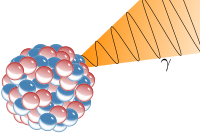
Photo from wikipedia
In this paper, we present the results of an ~5-h airborne gamma-ray survey carried out over the Tyrrhenian Sea in which the height range (77–3066) m has been investigated. Gamma-ray… Click to show full abstract
In this paper, we present the results of an ~5-h airborne gamma-ray survey carried out over the Tyrrhenian Sea in which the height range (77–3066) m has been investigated. Gamma-ray spectroscopy measurements have been performed using the AGRS_16L detector, a module of four 4L NaI(Tl) crystals. The experimental setup was mounted on the Radgyro, a prototype aircraft designed for multisensorial acquisitions in the field of proximal remote sensing. By acquiring high-statistics spectra over the sea (i.e., in the absence of signals having geological origin) and by spanning a wide spectrum of altitudes, it has been possible to split the measured count rate into a constant aircraft component and a cosmic component exponentially increasing with increasing height. The monitoring of the count rate having pure cosmic origin in the >3-MeV energy region allowed to infer the background count rates in the 40K, 214Bi, and 208Tl photopeaks, which need to be subtracted in processing airborne gamma-ray data in order to estimate the potassium, uranium, and thorium abundances in the ground. Moreover, a calibration procedure has been carried out by implementing the CARI-6P and Excel-based program for calculating atmospheric cosmic ray spectrum dosimetry tools, according to which the annual cosmic effective dose to human population has been linearly related to the measured cosmic count rates.
Journal Title: IEEE Transactions on Geoscience and Remote Sensing
Year Published: 2018
Link to full text (if available)
Share on Social Media: Sign Up to like & get
recommendations!